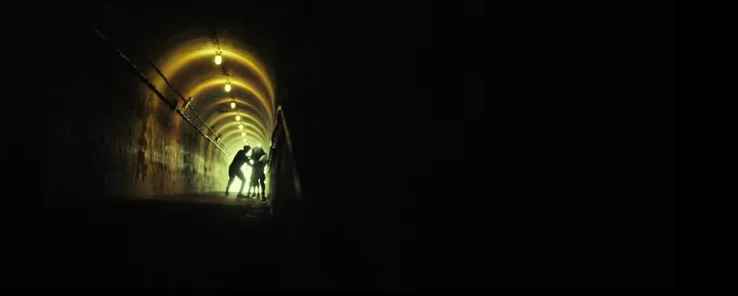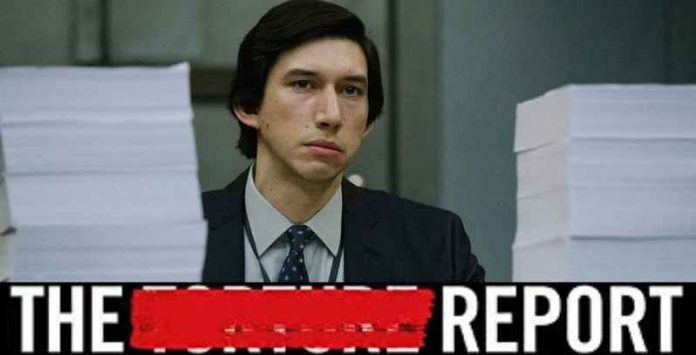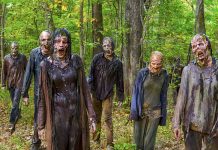ARTNEWSPRESS: The Report follows the real-life story of Daniel Jones (Adam Driver), a U.S. Senate investigator who, at the behest of Sen. Dianne Feinstein (Annette Bening), the then-chair of the Senate Select Committee on Intelligence, begins an exhaustive investigation of so-called “enhanced interrogation techniques” implemented by the CIA in the wake of 9/11. The deeper Jones dives into the 1.6 million documents, the quicker the investigation starts to bleed co-workers, sources and means.
The Report has many great qualities, starting with its actors. Adam Driver delivers a great performance as Daniel Jones, a role that could have been unbearably dull because we know nothing about Daniel other than he’s really good at his job. Driver spends 50 percent of his time on-screen either at his desk or sitting on increasingly uncomfortable chairs, trying to explain to Feinstein the many ways in which the CIA tortured prisoners and then tried to hide the evidence.

Jon Hamm, Corey Stroll and Matthew Rhys deliver great performances with characters that play to their strengths. On the CIA side, Michael C. Hall doesn’t have enough space within his lines to offer anything special, but Jennifer Morrison, Joanne Tucker and Maura Tierney play a perfect trio of CIA villains that will make your blood run cold.
But the real bad guys, according to the movie, are Bruce Jessen (Douglas Hodge) and James Mitchell (T. Ryder Smith), unqualified psychologists the CIA hired to develop the Enhanced Interrogation Techniques program across black sites, swallowing hook, line and sinker the claim that torture was essential to extract vital intelligence from suspected terrorists.
The scenes that follow are tough — the film switches between Jones reading and writing reports in his office and Jessen and Mitchell hitting, blinding, kicking, stripping, tying and waterboarding various prisoners — until one of them dies.
From a cinematography perspective, Burns brings his deft framing touch to the screen. Everything is carefully framed, and The Report shines in its aggressive use of architecture to convey the institutional elephant that could crush the characters at every turn. The movie also establishes subtle parallels between the spaces that the tortured prisoners occupy and the office where Daniel Jones worked. They are in dimly lit dungeon-like basements, surveyed by menacing men in denim.
Just like the prisoners, Jones loses track of time and as he learns more, he becomes more isolated from his colleagues and his superiors, which almost pushes him to go “the Snowden way.” Right before the end of the movie, Jones is crouching in a closet-sized office to keep his report safe, in the same position as a prisoner that appeared naked and shackled in a previous scene. The intent is to trace a metaphorical line between torturing prisoners and torturing the system of law that Jones represents, but it falls a little flat: for all his tireless work of half a decade, Jones wasn’t a prisoner and doing his job wasn’t torture.

The second half of the movie switches gears, settling into an excruciatingly slow series of scenes and conversations where Daniel keeps repeating — to anyone that will listen — that the CIA is illegally torturing prisoners in exchange for zero results and that everyone should know about it. The same information is hammered again and again, and nothing changes. It’s not a good sign for political thrillers when you can leave the room for 15 minutes and not miss any piece of vital information.
Some reviewers have argued that this marathon of meetings and documentation that is inflicted on the viewer to evoke the same frustration that Daniel experienced in real life while he created The Report, but that only works in movies or documentaries that offer something in exchange for the slow pace; either genuine and complete information (in the case of a documentary) or a dramatic catharsis of some kind (in the case of a dramatized movie), which The Report doesn’t offer.
The epilogue points out that not a single person performing or directing this torture was punished in any way, and that then-President Obama signed Executive Order 13491, forbidding Enhanced Interrogation Techniques. However, this statement feels disingenuous to any viewer with basic internet access: Order 13941 forbids torture, only “unless the Attorney General with appropriate consultation provides further guidance.” U.S. black sites are still open all over the world; both the Bush and Obama administrations refused to pursue any U.S. national that participated in these atrocities and President Trump has publicly pondered a return of waterboarding.

It would have been easy to include those facts, and more honest than the milquetoast ending of Daniel Jones slowly walking away from the White House. The direct result of these omissions is that The Report feels less like an exposé about the atrocities of war and more like a white-washing PR operation about U.S. government oversight and American exceptionalism.
The main issue with The Report is that it doesn’t fully commit to either the unvarnished-truth dramatized documentary that it feels like it should be nor to the over-the-top pathos of a “based-on-realeevents” political thriller. It starts as a political thriller, and then, for an hour and a half, it becomes a documentary about corrupt bureaucrats trying to finish with a semi-hopeful message that rings incredibly false. Yes, the subject matter is important, the performances are great and Burns does many interesting things with the photography and visual parallels, but all of those elements don’t quite combine into an exciting movie nor an honest documentary.
The Report was written and directed by Scott Z. Burns and produced by Steven Soderbergh. It stars Adam Driver, Annette Bening, Jon Hamm, Sarah Goldberg, Michael C. Hall, Douglas Hodge, Fajer Kaisi, Evander Duck Jr., Fajer Al-Kaisi, Zuhdi Boueri, Carlos Gómez, Pun Bandhu, Ratnesh Dubey, Ted Levine, Jennifer Morrison, Tim Blake Nelson, Linda Powell, Matthew Rhys, T. Ryder Smith, Corey Stoll, Joanne Tucker, and Maura Tierney. It premiered on November 15 and will be available on Amazon Prime on November 29.
https://cbr.com
Bea Caicoya
























